Rotating slip ring connectors are significant electromechanical devices that serve a critical function in many technological applications. Their primary purpose is to establish an electric connection, allowing power and signals to pass from a stationary platform to a part in rotation, and vice versa. This capability is fundamental in various sectors, including security, industrial machinery, renewable energy, and satellite communications, where maintaining a constant, non-twist electrical connection is of paramount importance.
In this insightful guide, we will delve into everything you need to know about rotating slip rings – their design, their operation, the typical applications they support, and the various types available in the market, each tailored for specific uses. We will discuss key factors to consider for selection and installation and offer expert advice on ensuring their peak performance through regular maintenance. Furthermore, we’ll address common concerns users have about these devices and shed light on recent technological advancements that have pushed their functionality even further.
Whether you are a seasoned engineer, an astute business owner, an aspiring student, or someone intrigued by the hows and whys of technology, this comprehensive guide will help you better understand the intricate world of rotating slip rings. Let’s embark on this enlightening journey together, as understanding the basics paves the way for effective application and future innovation.
Understanding Rotating Slip Rings
Rotating slip rings, often just called slip rings, are ingeniously designed electromechanical devices that play a crucial role in several electronic systems. At their core, slip rings permit both power and data to be transmitted between stationary and rotating components – a feat that is achieved through their unique design and functionality.
Slip rings primarily consist of two parts: a stationary part, often referred to as the stator, and a rotating part, known as the rotor. The stationary part typically houses the conductive brushes, usually made of a metal with high electrical conductivity, like gold, silver, or copper. These brushes slide on the rotating part that contains multiple circular conductive tracks, commonly known as rings.
These rings are separated from each other using an insulating material, often hard-wearing plastic or ceramic. As the rotor spins, the brushes maintain contact with the rings, creating an electrical connection capable of transmitting power, digital data, or analog signals. This solves a significant problem — it allows for the continued transfer of power or data even while part of the system is in motion.
But how does this principle work in practice? The key lies in keeping the brushes and the rings in constant contact. Once an electrical input is introduced to the stationary part, the current or data signal is picked up by the brushes that slide over the rings. These rings, in turn, being connected to the rotating part, conduct the current or signal to the connected components, thereby achieving the desired electrical continuity. This happens regardless of whether the stationary part, the rotating part, or both are moving.
It’s this fundamental operating principle that makes slip rings a cornerstone of many electronic systems. Their ability to maintain electrical continuity regardless of motion opens up a wealth of applications where uninterrupted signal or power transfer is necessary, making rotating slip rings an indispensable technology. Whether it’s reliable data communication or a consistent power supply that’s needed, the rotating slip ring has it all covered.
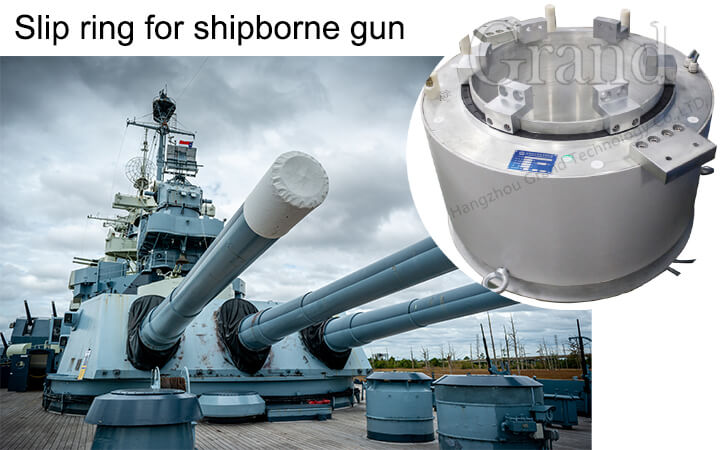
Applications of Rotating Slip Rings
Rotating slip rings have found a place in numerous sectors, thanks to their unique ability to ensure uninterrupted power and signal transmission. Their diverse applications span security systems, industrial machinery, the renewable energy sector, and even aerospace, each field leveraging the benefits of slip rings in distinct ways.
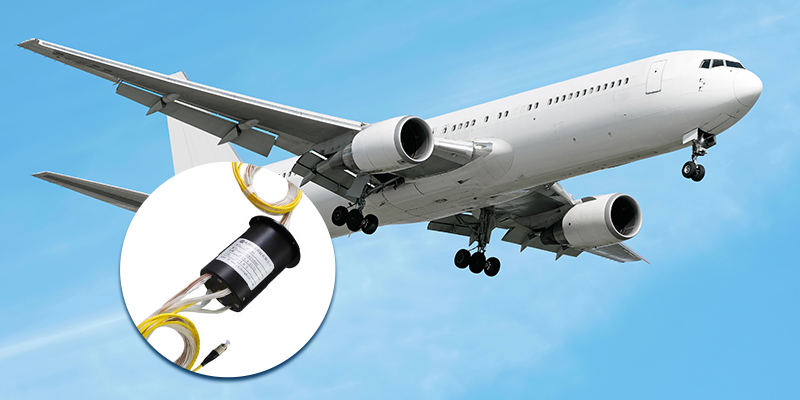
In security systems, especially with Closed-Circuit Television (CCTV) cameras, rotating slip rings play a crucial role. As these cameras rotate to capture a 360-degree field of view, the accompanying power and video signal cables risk becoming twisted, potentially causing significant operational disruption. Slip rings, thanks to their rotational capability, eliminate this risk by allowing limitless 360-degree rotation while maintaining continuous power and data transmission. This results in a more reliable, robust, and uninterrupted surveillance setup.
In the realm of industrial machinery, slip rings are often found in automated equipment—examples include robotic arms, cranes, and packaging machines. These machines typically require rotation or cyclical movement for their operation, but this constant motion can cause signal distortion in a standard wired setup. Rotating slip rings, thanks to their design that allows stable signal transmission despite the rotational movement, provide a solution to this problem, enabling these machines to function optimally.
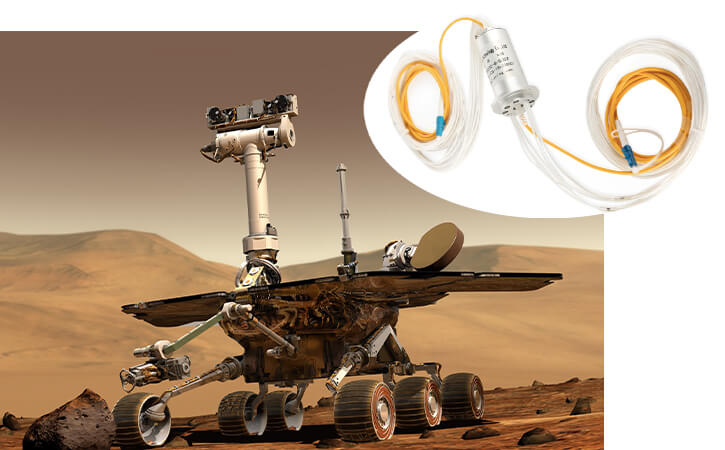
On the renewable energy front, wind turbines are an excellent example of where rotating slip rings are indispensable. As the turbine blades are continuously moving, the electric current generated by the generator needs to be transmitted to a stationary grid connection. A slip ring assembly installed inside the turbine nacelle enables this continuous power transmission amidst the constant blade rotation, thereby ensuring effective harnessing of wind energy.

Furthermore, slip rings also serve a pivotal role in satellite and radar systems within the aerospace sector. As these platforms require unrestrained, constant rotation to scan or communicate, the slip rings function as the critical conduit for transmitting power and signals, contributing to successful operations in space exploration and terrestrial defense systems.
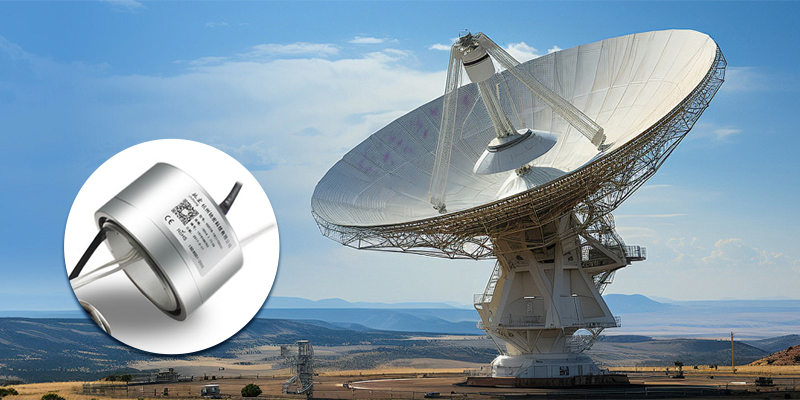
In summary, rotating slip rings play a vitally important role across various fields, alleviating potential issues that rotational motion might cause in power and signal transmission. By facilitating the continuous transfer of electrical currents or signals amidst rotation, slip rings significantly improve the reliability and efficiency of numerous systems, driving advances in our technological landscape.
Types of Rotating Slip Rings
Rotating slip rings are valued for their customizability, as they can be tailored to support a multitude of applications across diverse sectors. Understanding the different types and how their unique design and features cater to various needs is critical. Let’s explore some of the most common types – Capsule slip rings, Pancake slip rings, Ethernet slip rings, and Fiber optic slip rings.
Capsule Slip Rings
Capsule slip rings, also known as mini slip rings, are characterized by their compact and lightweight design. Usually cylindrical, these slip rings are designed to be small enough to fit into tight spaces, making them ideal for smaller devices and applications where space is a premium. Despite their small form factor, capsule slip rings offer impressive performance in terms of data and power transmission, managing both low and high levels of current.
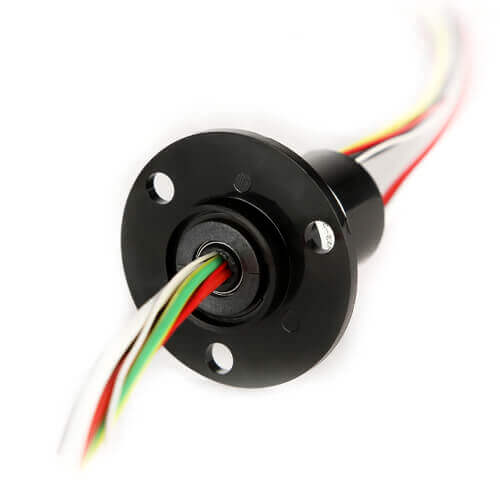
Pancake Slip Rings
Uniquely characterized by their flat, disc-like shape hence the name pancake, these slip rings are specially designed for applications where height restriction is a vital factor. Pancake slip rings arrange conductive rings in a horizontal layout, unlike the vertical alignment usually seen in capsule slip rings. While the flat design limits the number of channels, it makes them ideal for installations where vertical space is severely restricted.

Ethernet Slip Rings
Ethernet slip rings are a specialized variant engineered to support high-speed Ethernet communication. With the rise of Industry 4.0 and IoT (Internet of Things), the need for transmitting high-speed data over rotating interfaces has drastically increased. Ethernet slip rings, designed to transmit Ethernet protocols (like Gigabit Ethernet) without loss or disruption, perfectly cater to this need. They are integral to applications requiring real-time data transmission amidst constant rotation.
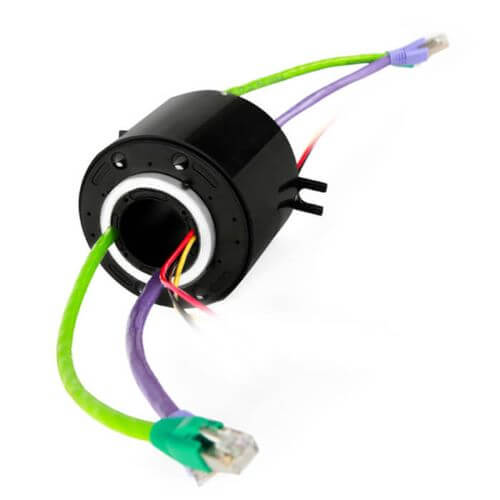
Fiber Optic Slip Rings
Fiber optic slip rings, or FORJs (Fiber Optic Rotary Joints), are the pinnacle of high-speed data transmission technology in the realm of slip rings. These devices provide the ability to transmit optical signals between a stationary and rotating interface, offering an extremely high data rate and bandwidth with zero electrical interference—an essential feature in high-end communication systems and sensitive instruments.
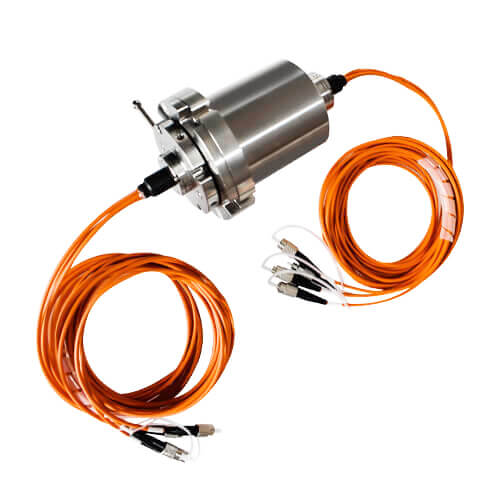
Each type of slip ring is distinct in its form, function, and features, with each offering unique advantages tailored to specific applications and constraints. It is essential to understand these differences and align them with your application to make an informed selection and, ultimately, to maximize system performance.
Selection Criteria for Rotating Slip Rings
Choosing the right rotating slip ring is not a one-size-fits-all situation. Several factors must be taken into consideration to ensure the chosen slip ring aligns perfectly with the user’s requirements. These factors include the number of channels needed, voltage requirements, expected operating speed, the level of durability, and more.
The Number of Channels
The term ‘channels’ in the context of slip rings refers to the number of individual circuits or paths for electrical contact that are needed in an application. The number of channels required is often proportionally linked with the complexity of the system. For example, a simple surveillance camera system may only need a few channels, whereas a complex industrial robot may need multiple channels for various power and signal needs. Users should understand their system’s requirements to select a slip ring with a suitable number of channels.
Voltage Requirements
Voltage requirements can vary significantly according to the system. Some systems may require a very low voltage, while others—especially power transmission systems—may need high voltage capacities. Ensuring the selected slip ring can handle the system’s voltage and current requirement is a critical factor.
Operating Speed
The operating speed of a slip ring refers to the rate at which the rotor part can safely rotate. For fast-paced, high-speed machinery, slip rings designed for high rotational speeds would be needed. Conversely, slower or more intermittent systems may not require the same level of speed capacity.
Durability and Environment
Durability is a significant factor and often correlates with the environment in which the slip ring will operate. If the environment is harsh, involving extreme temperatures, humidity, or exposure to dust or corrosive materials, a robust, long-lasting, and environment-proof slip ring would be the ideal choice. Conversely, less demanding environments might not necessitate such high-level durability.
Selecting the right slip ring means factoring in all these aspects and aligning them with the specific user requirements. It’s essential to have a keen understanding of both the system’s demands and the available slip ring options to make an effective choice that assures reliability, efficiency, and longevity. Armed with this knowledge, users can confidently navigate through the selection process and choose a slip ring that perfectly fits their needs.
Rotating Slip Rings Installation and Usage
The proper installation and usage of rotating slip rings are fundamental in ensuring they perform optimally and have a long lifespan. This guide outlines the basic steps for installing and using them correctly, emphasizing the crucial role of following manufacturer instructions and the potential implications of misuse.
Installation of Rotating Slip Rings
The foremost step in installing rotating slip rings is understanding the layout of your equipment and where the slip ring needs to be positioned. For instance, slip rings are typically installed in the rotating part of the equipment, but the specifics will depend on individual system design and the type of slip ring.
Once the location is determined, the slip ring should be fixed to the rotating part (rotor) of your system using the mounting mechanism provided by the manufacturer. It can range from flange mounting, end-of-shaft mounting, or through-bore mounting, among others. Ensure that the slip ring is secure and aligned properly.
The leads (wires) from the slip ring should then be connected to the conductive paths, following the instructions or diagrams provided by the manufacturer. It’s critical to verify the correct connections and avoid errors that could cause damage or malfunctions.
After installation, always conduct a final review of the overall system to ensure everything is set correctly before powering on your system.
Usage and Cautions
Proper use of rotating slip rings involves regular maintenance checks and adhering to precautionary tips to avoid damaging the slip rings. Here are some important notes to remember:
- Avoid sharp bends or stress upon the leads. They should be arranged such that they do not entangle or place undue pressure on the slip ring.
- Regularly inspect brushes and rings for wear and tear. If wear is excessive or uneven, this might be an indication of more serious issues.
- Maintain the recommended operational environment, including temperature, humidity, and contamination levels. Conditions beyond these recommendations may result in sub-optimal performance or damage to the slip rings.
Importance of Manufacturer Instructions
Instructions from the manufacturer should not be overlooked as they are specifically designed for the model and type of the slip ring. They include detailed installation steps, operational guidelines, and safety precautions that are crucial for the safe and efficient use of the slip ring.
Implications of Misuse
Misuse or improper handling of rotating slip rings can lead to several issues. It can cause electric faults, damage the slip ring, reduce lifespan, and even pose safety hazards. Cautious installation and handling are critical to avoid these issues and ensure effective, long-lasting operation.
To conclude, understanding the correct installation procedures and adhering to proper usage guidelines is the key to maximizing the performance and longevity of rotating slip rings, thereby ensuring a reliable and efficient operation of the end application itself.
Rotating Slip Rings Maintenance and Troubleshooting
Maintenance and troubleshooting are vital aspects of owning and operating rotating slip rings. Paying attention to routine maintenance can prevent common issues and prolong the lifespan of the slip ring. Furthermore, learning how to effectively troubleshoot common problems can help maintain the performance of the slip ring within your system.
Routine Maintenance
Routine maintenance is the key to maintaining the functionality and prolonging the lifespan of rotating slip rings. Follow these general maintenance tips:
- Cleaning: Ensure the slip ring’s surfaces are clean, particularly the brushes and rings. Accumulated dirt and pollutants can induce electrical resistance or produce undesirable noise.
- Inspection: Regularly inspect the slip ring for signs of wear and tear, especially on the contact surfaces. Excessive or uneven wear can be an indication of larger issues.
- Lubrication: In some types of slip rings, periodic lubrication of the contact surfaces may be needed to reduce friction and wear. Refer to your manufacturer’s instructions regarding the need and type of lubrication.
- Environmental Checks: It’s crucial to ensure the operational environment remains within the purchase specifications. Humidity, temperature, and contamination levels should be kept within the manufacturer-recommended levels.
Troubleshooting Common Problems
Should problems arise, it’s key to have the ability to troubleshoot quickly and effectively. Common problems and their potential solutions include:
- Poor Signal Quality: This can be due to dirty or worn contact surfaces. Cleaning the surfaces or replacing worn parts could help improve the signal quality.
- Electrical Noise: Ensure grounding has been correctly implemented. Also, check for the buildup of dirt or pollutants and clean if necessary.
- Intermittent Power/Signal: Check for any loose connections or damage to the cables. If the contact surfaces are worn excessively, this might also cause intermittent signals.
Remember, always consult the manufacturer’s guide or reach out to their support for issues that you cannot diagnose or fix.
In Summary
Regular maintenance and effective troubleshooting are essential processes when operating rotating slip rings. By taking preventative measures to maintain the slip ring and by knowing how to diagnose and solve common problems efficiently, you can ensure that the slip ring continues to function optimally and meet the demands of your system. Consequently, this secures the reliability and efficiency of your entire rotating system.
Rotating Slip Rings Most Common User Concerns
When selecting, installing, and maintaining rotating slip rings, users often have several concerns. Addressing these concerns is vital for ensuring optimal performance and user satisfaction. Below are some of the most common concerns and advice for tackling them:
Lifespan
One of the primary concerns in the use of rotating slip rings is their lifespan. Users need a slip ring that provides long-lasting, reliable service. Here are a few suggestions to address this concern:
- Choose a slip ring with a robust design, durable materials, and longevity in line with the system’s needs.
- Keep up with regular maintenance, including cleaning, inspection, and lubrication as required.
- Ensure the operating environment complies with the manufacturer’s specifications.
Compatibility
Compatibility with existing equipment and system requirements is a crucial concern. Needing a slip ring that serves its purpose without adversely affecting the surrounding system is essential. To ensure compatibility:
- Understand your system requirements, including the number of channels, voltage range, operating speed, and environmental factors.
- Select a slip ring designed for the specific application, ensuring it aligns with the needs of your system.
- Consult with the manufacturer or supplier for guidance, especially if unsure about any aspect of compatibility.
Maintenance
Proper maintenance is vital for the efficient and reliable operation of rotating slip rings. Users may be concerned about the complexity or frequency of maintenance tasks. To address these concerns:
- Opt for slip rings with low-maintenance or maintenance-free designs, such as some fiber brush slip rings for lower maintenance needs.
- Create a routine maintenance schedule to ensure the slip ring receives timely maintenance checks with minimal downtime.
- Consult the manufacturer’s manual to have a clear understanding of the required maintenance procedures and intervals.
Cost
Cost concerns revolve around the initial investment, maintenance, and replacement expenses for rotating slip rings. To minimize costs and maximize the return on investment:
- Assess the long-term value of the slip ring, including quality, lifespan, and maintenance costs. Opt for a product that balances quality with affordable cost.
- Invest in preventive maintenance, as this can save expenses in the long run related to replacements or repairs.
- Evaluate repair and replacement costs in advance, and include these considerations when selecting a slip ring.
In summary, addressing users’ common concerns about rotating slip rings is essential for ensuring optimal performance, satisfaction, and a positive overall experience. By selecting the right slip ring, adhering to proper usage and maintenance guidelines, and weighing factors such as cost and compatibility, users can effectively manage and mitigate these concerns, leading to a smooth and pleasant experience throughout the entire process.
Rotating Slip Rings Recent Technological Advancements
The field of rotating slip rings has witnessed many developments recently, driven by advancements in technology. These innovations have led to improved functionality, enhanced reliability, and expanded applications for rotating slip rings. This section discusses these advancements and their impact on the performance and utility of rotating slip rings.
Technological Advancements in Rotating Slip Rings
- Fiber Optic Slip Rings (FORJ): Fiber optic slip rings or FORJs represent a quantum leap in slip ring technology. They enable the transmission of optical signals along with electrical signals, allowing high-speed data transfer without electromagnetic interference.
- Wireless Slip Rings: Leveraging wireless technology, these slip rings have no physical contact between stationary and rotating parts. This reduces wear and tear, essentially removing maintenance requirements and expanding slip ring lifespan.
- Integrated Slip Rings: Advances in integrated designs allow slip rings to combine with other components like rotary joints, encoders, or fluid rotary unions. This paves the way for compact and efficient designs that save space and reduce installation complexities.
- Smart Slip Rings: The advent of the Internet of Things (IoT) and AI has impacted slip ring technology as well. Smart slip rings equipped with sensors and AI can monitor operation, predict wear and tear, offer maintenance reminders, and more.
Impact of Advancements on Performance and Utility
Each of these advancements has positively influenced the performance and usability of rotating slip rings:
- Fiber Optic Slip Rings: They offer higher bandwidth data transmission, enabling slip rings to handle a broader range of signals, making them suitable for telecommunications, high-speed cameras, and other high-data applications.
- Wireless Slip Rings: By removing the contact aspect, they hugely enhance lifespan and reliability while reducing maintenance needs. This transforms them into a viable option for applications requiring a near-zero maintenance environment.
- Integrated Slip Rings: The ability to pair with other components has made rotating slip rings more versatile. This increases functionality while reducing space requirements, beneficial for confined space applications.
- Smart Slip Rings: With predictive maintenance and real-time monitoring, these slip rings increase reliability and reduce unexpected downtime. This significant advancement further enhances their utility across various sectors.
In essence, recent technological advancements in rotating slip rings have set new standards in performance, functionality, and utility. By integrating advanced technologies, these devices are equipped for better compatibility with modern applications, ultimately resulting in higher user satisfaction and expanded possibilities for the future.
Conclusion
Rotating slip rings are integral components in countless applications, providing efficient and reliable data and power transmission. By understanding the different types, selection criteria, and best practices for maintenance, you’ll be better equipped to harness their potential and incorporate them into your applications effectively. Keep exploring and learning about rotating slip rings, and unlock the immense possibilities they offer.
See What We Can Do
